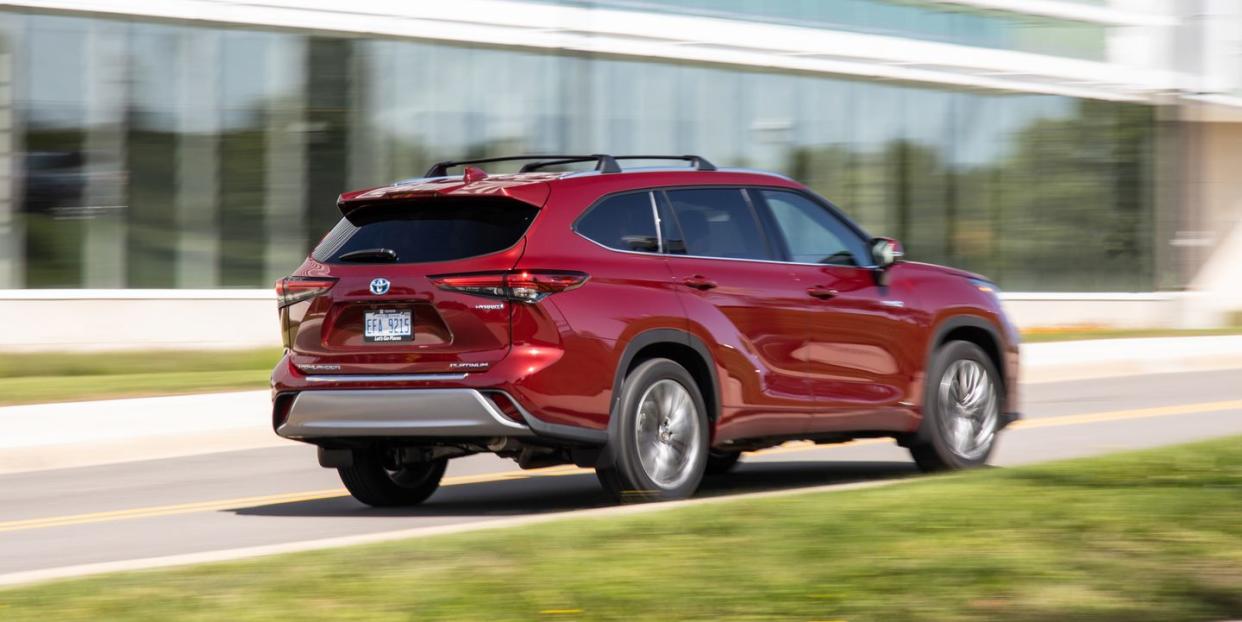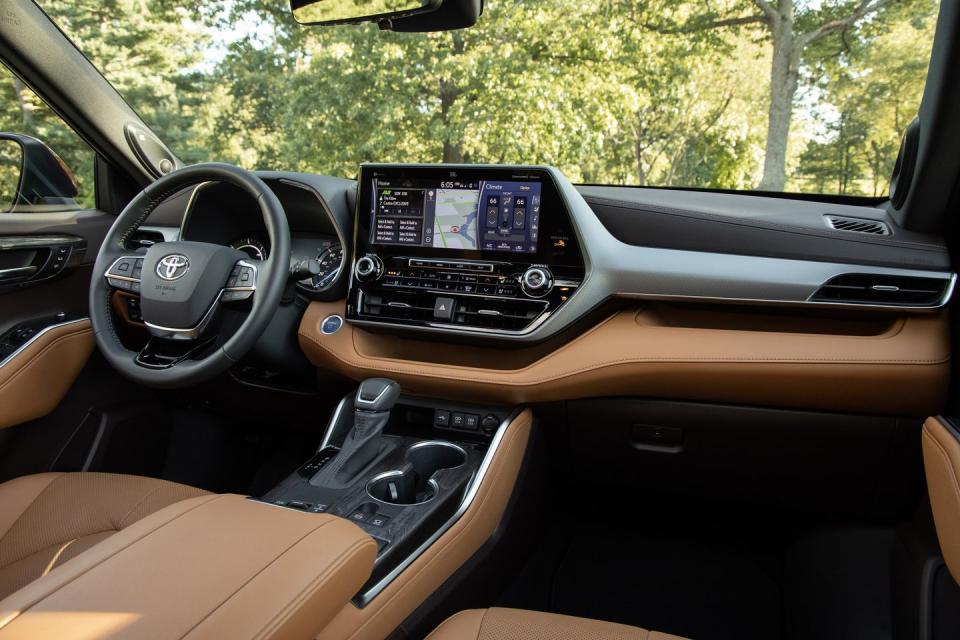Tested: 2020 Toyota Highlander Hybrid Is a Three-Row Prius

Fire up the Google machine, type in "mid-size crossovers," and prepare to scroll through roughly 1.3 million pages of results. Add "hybrid" into that same search and you'll see significantly fewer results. Drop in a few more filters—three rows of seats, a starting price of less than $40,000, and fuel-economy ratings that all exceed 33 mpg—and the lone match will be the new 2020 Toyota Highlander hybrid. And yes, for the purposes of this argument, we'll ignore the 2021 Toyota Sienna and the Chrysler Pacifica Hybrid, both of which might meet most of the criteria but fail to posture as symbols of a rugged outdoor lifestyle.
Less Powerful Engine, but More Efficient
Fresh off a full redesign, the fourth generation of Toyota's extremely popular three-row SUV boasts millennial-approved tech features, luxury-grade road manners, and bodywork that's more chiseled than the version it replaces. We've already pitted the regular Highlander against the Honda Pilot and had it face off with the Kia Telluride, but now we've driven its hybrid counterpart in isolation. This includes switching from a 3.5-liter V-6 to a 2.5-liter Atkinson-cycle inline-four and introducing front-wheel drive as standard with the hybridized powertrain. The Highlander hybrid also continues to offer an optional rear-mounted electric motor to provide all-wheel drive without actually running a prop shaft back from the front end.

The smaller internal-combustion engine still teams with a pair of electric motor-generators, but the system's combined output is now 243 horsepower versus the six-pot's 306-hp combo. However, Toyota says downsizing helped create a lighter package with fewer frictional losses. Indeed, our fully loaded Platinum tester weighed 276 pounds less than the 2017 Highlander hybrid we tested, and we found the transition from six to four cylinders to have a negligible effect on acceleration. The new version was only 0.3 second slower to 60 mph, recording a respectable 7.3-second run with the help of all-wheel drive. Yes, the four-cylinder hybrid needed almost an extra second to charge from 50 to 70 mph, but we didn't much notice that deficit when we needed to pass dawdlers or merge onto the highway. The old powertrain's quarter-mile performance was slightly quicker and faster at the drag strip, too. But let's be real: If you see anyone in a hybrid Highlander moonlighting as John Force, they probably work for us.
And anyway, horsepower ratings and acceleration times are probably about as important to hybrid shoppers as carbon emissions and noise ordinances are to Hellcat customers. Highlander Hybrid buyers prioritize efficiency, and on that front Toyota made great strides over the last-gen hybrid, posting a combined EPA fuel-economy rating that now peaks at 36 mpg—a 7-mpg improvement. The gains versus the non-hybrid gas model are also substantial, with the all-wheel-drive hybrid boasting EPA estimates of up to 35 mpg city and highway, which represent increases of 15 and 8 mpg, respectively. That makes the Toyota the most fuel-efficient three-row crossover you can buy, presuming we ignore luxury EVs like the Tesla Model Y, with its 125 MPGe rating.

Newfound Refinement and Greater Luxury
The Highlander's hybrid powertrain is most efficient in urban environments where stop-and-go traffic helps the battery recoup energy from the regenerative-braking system. However, we accumulated the majority of our 1100-plus miles on the interstate, a driving regimen that's reflected in our observed 29 mpg. While highway cruising doesn't showcase the Highlander's electrified efficiency, it did show off its impressive range between fill-ups. If you managed to hit the AWD model's 35-mpg EPA highway rating, you'd go more nearly 600 miles between fuel stops, meaning that on road trips you'll likely need a break before the Highlander will.
Racking up hundreds of miles on I-75 to and from a campground in Michigan's Upper Peninsula gave us time to appreciate the hybrid Highlander's composure at speed. Its nicely weighted steering and serene ride quality make it one of the better driving crossovers in its class. To be clear, it's not exciting, but the controls are cohesive and satisfying. The adoption of the company's ubiquitous TNGA-K platform has clearly paid dividends for the new Highlander, which now evinces the refinement and stolid composure of a Lexus.

The Highlander's newfound luxuriousness is also evident in its greatly improved interior. Our top-of-the-line Highlander Platinum was outfitted with Glazed Caramel leather upholstery and a huge 12.3-inch touchscreen. Unfortunately, the infotainment interface's graphics aren't as slick as other systems, and there's a permanent floating sidebar that prevents dedicating the entire screen to any given function. Likewise, the interior's bountiful storage cubbies don't excuse the center-console bin's tight opening or the tilting wireless charger that was an obstruction every time we opened the lid. It's like Toyota wanted to offer wireless charging but couldn't think of anywhere else to put the pad.
The Three-Row Hybrid to Buy
Looking past those minor gripes and confronting a couple of fundamental ones, the hybrid Highlander can't tow more than 3500 pounds, and the third row is tight for adults. Our Platinum's as-tested price of $51,068 might raise some eyebrows, too, but forego its 20-inch wheels, 1200-watt JBL stereo system, ventilated front seats, and panoramic sunroof and you can get a well-equipped Highlander XLE hybrid with all-wheel drive for less than $44,000. Settle for even fewer creature comforts, and the front-wheel-drive LE hybrid starts at $40,975.

The three-row mid-size crossover segment is huge, and the best examples have some defining characteristics—the Mazda CX-9 with its upscale interior or the Dodge Durango with its overkill V-8 horsepower. While the non-hybrid Toyota Highlander isn't particularly special, the eco-friendly model is the best three-row hybrid. The only comparable alternative is the recently redesigned Ford Explorer. But its hybrid powertrain is only offered in one trim that starts north of $50,000, and all of its EPA estimates are below 30 mpg. So, if fuel efficiency and value are your top search criteria, the 2020 Highlander Hybrid is the obvious choice.
You Might Also Like

 Yahoo News
Yahoo News 
